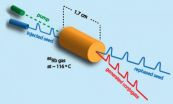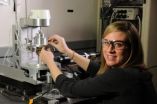(Press-News.org) Researchers at the National Institute of Standards and Technology (NIST) have developed and published a new protocol for communicating with biometric sensors over wired and wireless networks—using some of the same technologies that underpin the web.
The new protocol, called WS-Biometric Devices (WS-BD), allows desktops, laptops, tablets and smartphones to access sensors that capture biometric data such as fingerprints, iris images and face images using web services. Web services themselves are not new; for example, video-on-demand services use web services to stream videos to mobile devices and televisions.
The WS-Biometric Devices protocol will greatly simplify setting up and maintaining secure biometric systems for verifying identity because such biometric systems will be easier to assemble with interoperable components compared to current biometrics systems that generally have proprietary device-specific drivers and cables. WS-BD enables interoperability by adding a device-independent web-services layer in the communication protocol between biometric devices and systems.
Remember the last time you bought a new computer only to learn that you then had to upgrade your printer and find the appropriate drivers? For system owners, the difficulty of upgrading devices on a biometric system can mean significant costs. Using the WS-BD protocol eliminates that problem.
"This would be useful to many organizations that house biometric systems, including border control and customs agencies," explained computer scientist Kevin Mangold. Using current biometric systems, when one biometric sensor breaks, it can be expensive and time-consuming to find a replacement because manufacturers often change product lines and phase out previous generation devices. A few broken devices could entail having to rebuild the entire system, upgrade devices and drivers that may be incompatible with host operating systems, and retrain personnel, he said.
Biometrics are playing an increasing role in security, access control and identity management. And their use is expanding—for example, some theme parks use biometrics for access control. Fingerprints are used in conjunction with passwords for computer security. Many jobs require employees to provide biometrics; using WS-BD equipment could potentially reduce costs by facilitating interoperability in biometrics devices.
A 2010 National Academies study, Biometric Recognition: Challenges and Opportunities, recognized that "Biometric systems should be designed to anticipate the development and adoption of new advances and standards, modularizing components that are likely to become obsolete, such as biometric sensors, and matcher systems, so that they can be easily replaced."
NIST researchers recognized this need several years ago and developed a solution with the support of the Department of Homeland Security Science and Technology Directorate, the Federal Bureau of Investigation's Biometric Center of Excellence and NIST's Comprehensive National Cybersecurity Initiative. NIST also is working with industry through the Small Business Innovation Research Program to help bring these plug-and-play biometric devices to market.
Two NIST researchers recently demonstrated the NIST-developed WS-BD system in their lab using a tablet and two biometric sensors (see video). A tap on the tablet signals the web-enabled fingerprint sensor to capture four fingerprints from the individual whose hand is on the scanner and send it back to the tablet. A tap on another button controls a camera to take a photo for facial recognition.
###The new protocol, Specification for WS-Biometric Devices (NIST Special Publication 500-288) can be found at www.nist.gov/manuscript-publication-search.cfm?pub_id=910334. Additional information on this and related projects can be found at http://bws.nist.gov.
While this is a final document, NIST welcomes your feedback, comments and questions for considerations for future updates. Send your comments to the WS-BD teams by emailing 500-288comments@nist.gov.
Watch presentation on YouTube at
http://www.youtube.com/watch?v=VTxIA-wkmo0&feature=player_embedded
New protocol enables wireless and secure biometric acquisition with web services
2012-05-04
ELSE PRESS RELEASES FROM THIS DATE:
First light: NIST researchers develop new way to generate superluminal pulses
2012-05-04
Researchers at the National Institute of Standards and Technology (NIST) have developed a novel way of producing light pulses that are "superluminal"—in some sense they travel faster than the speed of light.* The technique, called four-wave mixing, reshapes parts of light pulses and advances them ahead of where they would have been had they been left to travel unaltered through a vacuum. The new method could be used to improve the timing of communications signals and to investigate the propagation of quantum correlations.
According to Einstein's special theory of relativity, ...
Fabrication method can affect the use of block copolymer thin films
2012-05-04
A new study by a team including scientists from the National Institute of Standards and Technology (NIST) indicates that thin polymer films can have different properties depending on the method by which they are made. The results* suggest that deeper work is necessary to explore the best way of creating these films, which are used in applications ranging from high-tech mirrors to computer memory devices.
Thin films spread atop a surface have many applications in industry. Inexpensive organic solar cells might be made of such films, to name one potential use. Typically ...
Science nugget: Lightning signature could help reveal the solar system's origins
2012-05-04
Every second, lightning flashes some 50 times on Earth. Together these discharges coalesce and get stronger, creating electromagnetic waves circling around Earth, to create a beating pulse between the ground and the lower ionosphere, about 60 miles up in the atmosphere. This electromagnetic signature, known as Schumann Resonance, had only been observed from Earth's surface until, in 2011, scientists discovered they could also detect it using NASA's Vector Electric Field Instrument (VEFI) aboard the U.S. Air Force's Communications/Navigation Outage Forecast System (C/NOFS) ...
Ultrasound idea: Prototype NIST/CU bioreactor evaluates engineered tissue while creating it
2012-05-04
Researchers at the National Institute of Standards and Technology (NIST) have developed a prototype bioreactor—a device for culturing cells to create engineered tissues—that both stimulates and evaluates tissue as it grows, mimicking natural processes while eliminating the need to stop periodically to cut up samples for analysis. Tissue created this way might someday be used to replace, for example, damaged or diseased cartilage in the knee and hip.
Conventional methods for evaluating the development and properties of engineered tissue are time-consuming, destructive ...
Prompt Proofing Blog Post: Revisiting Homophones 3
2012-05-04
In this month's grammar post we are taking another look at some frequently confused homophones. All of the homophones below have been recently spotted, used erroneously, in business communications or copy!
Click here for our first homophones blog post, and here for our second.
insure / ensure
You only insure something in the legal sense - dealing with an insurance company. If you want to make sure something happens you will ensure it. Hence: You insure your car to ensure you will not lose out financially if it is stolen or damaged.
precede / proceed
If something ...
Study examines necessity of additional imaging in PET/CT oncologic reports
2012-05-04
Radiologists and nuclear medicine physicians recommended additional imaging about 30% of the time in oncologic PET/CT reports, with about half of those recommendations being unnecessary, a new study shows.
The study, conducted at Brigham and Women's Hospital in Boston, included 250 patients. The study found that there were 84 recommendations made for additional imaging. When study reviewers examined the patients' records, they concluded that 43 of those recommendations were unnecessary, said Atul Shinagare, MD, one of the authors of the study. No adverse patient outcome ...
6 month follow-up of patients with benign MRI-guided breast biopsies may not be necessary
2012-05-04
Short term follow-up of patients who have had a negative (benign) MRI-guided vacuum assisted breast biopsy may not be necessary, a new study indicates.
The study, conducted at Yale New Haven Hospital in Connecticut, included 144 patients with 176 lesions that were followed anywhere from three months to 36 months. The study found no malignancies on follow-up MR imaging, said Jaime Geisel, MD, one of the authors of the study. Two patients had suspicious findings at follow-up and underwent a second biopsy six months after the initial biopsy; one yielded benign results and ...
Preop MRI valuable in detecting additional malignancies in dense & not dense breasts
2012-05-04
Newly diagnosed breast cancer patients should undergo a preoperative MRI exam even if their breasts are not dense, a new study indicates. The study found no difference between the usefulness of 3T breast MRI in detecting additional malignancies and high risk lesions in dense versus non-dense breasts.
"There are currently no guidelines that define the role of breast density in determining if a preoperative MRI should be performed. However, anecdotally, we know that preoperative MRI exams tend to be ordered more frequently in younger patients and/or patients with dense ...
Spain's Balearic Islands Now Open to Charter Yachts
2012-05-04
The Balearic islands of Mallorca, Ibiza, Minorca and Formentera, along with mainland cities such as Barcelona, Valencia and Marbella can now be added to Europe's established 'charter' destinations.
With the longest summer season in Europe, and reliable sunshine from April through until late Autumn, these exclusive destinations can now add as much as 75 days to the European cruising season - This now brings a season that incorporates Easter through until the famous "Club closing parties of Ibiza" and the late Autumn sunshine on the southern Iberian peninsula. ...
Radiologists study necessity of additional imaging recommendations in PET/CT oncologic reports
2012-05-04
Advanced imaging has been identified as one factor that contributes to the overall rising cost of healthcare in the US. Unnecessary or inappropriate imaging utilization magnifies the cost burden associated with advanced imaging studies like MRIs and PET/CT scans. Though these studies often provide the best clinical information for making a diagnosis or planning treatment, experts suspect that a significant number of unnecessary studies are performed. Determining the rate of unnecessary imaging can help guide both policy-makers and physicians to develop guidelines that would ...





